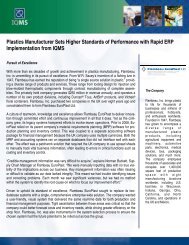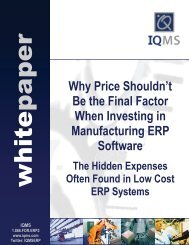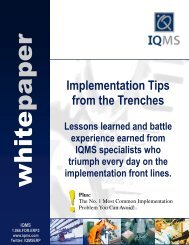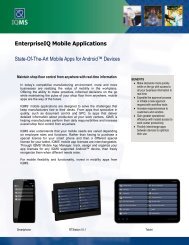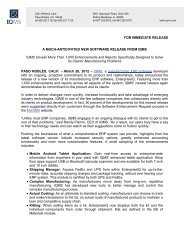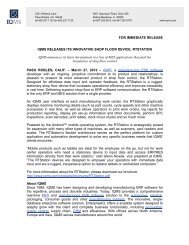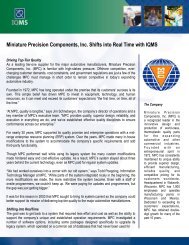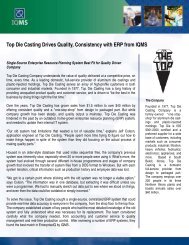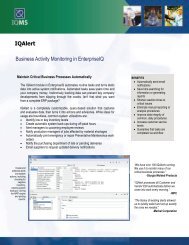ERP for beginners - IQMS
ERP for beginners - IQMS
ERP for beginners - IQMS
You also want an ePaper? Increase the reach of your titles
YUMPU automatically turns print PDFs into web optimized ePapers that Google loves.
<strong>ERP</strong> <strong>for</strong> <strong>beginners</strong><br />
Mark Bosse is an<br />
independent <strong>ERP</strong><br />
consultant <strong>for</strong> <strong>IQMS</strong>,<br />
developers of EnterpriseIQ,<br />
an <strong>ERP</strong> software <strong>for</strong> the<br />
plastics industry.<br />
Chances are you’ve heard<br />
the buzz around <strong>ERP</strong><br />
(enterprise resource planning),<br />
the software that integrates<br />
scheduling, production, sales,<br />
accounting, and other manufacturing<br />
and front office tasks into one<br />
computer-based system. Sounds<br />
good on paper and, indeed, a properly<br />
implemented <strong>ERP</strong> system can<br />
deliver production efficiency,<br />
reduced labor costs, and improved<br />
customer service, no matter the size<br />
of the manufacturer.<br />
<strong>ERP</strong> as a concept is simply too<br />
compelling to ignore. It makes sense<br />
to replace a paper calendar or multiple<br />
outdated accounting and spreadsheet<br />
software programs with an<br />
integrated system that stores and<br />
sorts the in<strong>for</strong>mation flowing in from<br />
all areas of your plant floor, front<br />
office, and supply chain. A properly<br />
implemented <strong>ERP</strong> system can deliver<br />
good results and dramatically<br />
improve your ability to reduce costs,<br />
run leaner, and provide good customer<br />
service.That’s the good news.<br />
The bad news is that the track<br />
record of <strong>ERP</strong> within the plastics<br />
and rubber industries has been less<br />
than stellar. Overall abandonment<br />
rates of <strong>ERP</strong> <strong>for</strong> generic manufacturing<br />
range from 10 to 25 percent.<br />
Estimates within the plastics and<br />
moldmaking industries put the failure<br />
rate at close to 30 percent. Not<br />
exactly the success rate you want<br />
when you invest in expensive software<br />
<strong>for</strong> your business, is it?<br />
Now, be<strong>for</strong>e you throw up your<br />
hands and dismiss <strong>ERP</strong>, let’s take a<br />
look at your reasons <strong>for</strong> needing an<br />
<strong>ERP</strong> system and some of the things<br />
you can do to increase your ability to<br />
reap the benefits that <strong>ERP</strong> offers.<br />
THE BASICS OF <strong>ERP</strong><br />
Let’s start at the beginning. <strong>ERP</strong><br />
puts into action a very simple concept:<br />
managing each area of your<br />
business efficiently. At its inception<br />
in the ‘90s, <strong>ERP</strong> meant the integration<br />
of manufacturing resource<br />
planning, or MRP, and some<br />
accounting and human resource<br />
management functions. At its heart<br />
is the ability to match inventories<br />
with demand: schedule manufacturing<br />
operations, create work orders,<br />
track labor and materials, and tie<br />
manufacturing to other areas of the<br />
business, such as sales and distribution,<br />
accounting, production monitoring,<br />
and reporting.<br />
Since its inception, <strong>ERP</strong> has<br />
broadened to encompass many<br />
more functions. Indeed, in addition<br />
to the core manufacturing and front<br />
office functions, <strong>ERP</strong> has expanded<br />
to include elements of customer<br />
relationship management (CRM),<br />
warehouse management systems<br />
(WMS), electronic data interchange<br />
(EDI), and even integrated quality<br />
management (IQM), which goes<br />
beyond the four walls of the enterprise.<br />
The term “<strong>ERP</strong> II” is now
identifies systems that integrate<br />
these new features into<br />
<strong>ERP</strong> systems.<br />
THE REAL DEAL<br />
So what does this all mean <strong>for</strong><br />
plastics processors? And what<br />
should you look <strong>for</strong> in an<br />
<strong>ERP</strong> system, and the vendor<br />
that provides it? After all,<br />
even some <strong>ERP</strong> systems that<br />
claim to be “plastics-specific”<br />
are missing major capabilities,<br />
such as integrated realtime<br />
production monitoring,<br />
customer relationship management,<br />
and the quality control<br />
so critical to maintaining<br />
ISO and other quality certifications.<br />
Set realistic goals. A<br />
good <strong>ERP</strong> system can make<br />
you a more efficient manufacturer<br />
and pave the way to<br />
future growth, but it won’t do<br />
this overnight. Be<strong>for</strong>e you<br />
begin the search <strong>for</strong> a new<br />
<strong>ERP</strong> system, you should look<br />
at what it is that your business<br />
is lacking with its current system,<br />
whether it be computer<br />
or paper based, and use it as<br />
the starting point <strong>for</strong> your<br />
<strong>ERP</strong> search. A good <strong>ERP</strong><br />
vendor can help you define<br />
and refine your goals and<br />
objectives and lay a blueprint<br />
<strong>for</strong> how the software addresses<br />
those goals and objectives.<br />
Choose software suited<br />
to your industry or<br />
type of manufacturing.<br />
Look <strong>for</strong> a software package<br />
suited to what you do. Does it<br />
have easy creation of new<br />
projects? Does it have graphics<br />
scheduling and allow you<br />
to easily convert sales orders<br />
into work orders? Can it handle<br />
the unique demands of a<br />
contract manufacturing environment?<br />
If your mold shop<br />
is part of a larger manufacturing<br />
organization, does the<br />
<strong>ERP</strong> system link to those<br />
The power of an <strong>ERP</strong> system lies in its<br />
ability to integrate your business<br />
processes into one single data source.<br />
Choose a system that allows you to<br />
move quickly through all areas of the<br />
software, rather than a patchwork of<br />
“best-of-breed” solutions.<br />
Customer Relationship Management, or<br />
CRM, is now standard with many <strong>ERP</strong><br />
systems.To avoid costly customizing and<br />
troublesome interfaces, make sure your<br />
CRM is developed by your <strong>ERP</strong> vendor,<br />
rather than patched from a third-party<br />
vendor.<br />
Some advanced <strong>ERP</strong> systems offer<br />
integrated quality management, such<br />
as the corrective action request<br />
protocol demonstrated above, which is<br />
vital to maintaining certifications such<br />
as ISO and QS.<br />
other manufacturing types?<br />
There are many software<br />
packages that claim to be<br />
“plastics-specific,” but few<br />
can handle the specific<br />
requirements of plastics<br />
processing without costly<br />
customizing.<br />
Choose a vendor<br />
that knows your industry.<br />
One of my favorite<br />
stories is from a large plastics<br />
processor who invited a<br />
generic <strong>ERP</strong> vendor, who<br />
shall remain anonymous,<br />
to come in <strong>for</strong> a sales<br />
demonstration. The presentation<br />
included three<br />
well-dressed salespeople,<br />
high-tech graphics, eyecatching<br />
charts, and lots of<br />
<strong>for</strong>midable-sounding technology<br />
jargon. There was<br />
just one problem with the<br />
demonstration: It was on<br />
how to manufacture wooden<br />
cabinets. What was supposed<br />
to be a sales demonstration<br />
turned into a tutorial,<br />
with the manufacturer<br />
giving the <strong>ERP</strong> salespeople<br />
an ad-hoc lesson on how to<br />
manufacture and assemble<br />
plastic products. The point<br />
is that you can save a lot of<br />
grief if you begin your<br />
selection with <strong>ERP</strong> vendors<br />
that have experience with<br />
repetitive manufacturing<br />
environments such as plastics<br />
processing. Ask vendors<br />
<strong>for</strong> references.<br />
Choose an <strong>ERP</strong> system<br />
that already integrates<br />
the features you<br />
need. When you evaluate<br />
<strong>ERP</strong> packages you should<br />
look at the core features<br />
that come integrated into<br />
the sticker price, as well as<br />
those that can be added on<br />
as your company grows.<br />
Experience proves that you<br />
can reduce your imple-
mentation time and ultimately have<br />
a more productive system if you<br />
choose an <strong>ERP</strong> program that integrates<br />
the features you need rather<br />
than requiring you to bundle a lot of<br />
third-party software together. Many<br />
<strong>ERP</strong> horror stories begin and end<br />
with getting two software systems to<br />
talk to each other. The less time you<br />
spend interfacing your <strong>ERP</strong> package<br />
with other software systems, such as<br />
your document control and workflow<br />
<strong>for</strong> ISO, the happier you’ll be.<br />
If you need real-time production<br />
monitoring, graphic scheduling, links<br />
to the general ledger, the ability to<br />
account <strong>for</strong> family tooling capabilities,<br />
or “capable to promise” (a function<br />
that lets manufacturers evaluate current<br />
inventory and capacity to determine<br />
fulfillment capabilities), make<br />
sure that they’re integrated as core<br />
features. More importantly, make sure<br />
they are on the same database so you<br />
don’t end up managing two or three<br />
separate sets of data. Create a priority<br />
list of the functions you need and<br />
grade each vendor on its ability to<br />
meet those needs with its own native<br />
products.<br />
Buy to what your needs will<br />
be in a year and beyond. It’s<br />
understandable, especially in the<br />
slowed economy, <strong>for</strong> plastics processors<br />
to want the lowest-priced <strong>ERP</strong> system<br />
available. Un<strong>for</strong>tunately, the old adage<br />
that “you get what you pay <strong>for</strong>” is especially<br />
true when it comes to <strong>ERP</strong> systems.<br />
When you buy an <strong>ERP</strong> system<br />
you’re making an investment that<br />
affects every area of your business from<br />
that point <strong>for</strong>ward. Maybe one of the<br />
low-priced or off-the-shelf software<br />
products is ideal <strong>for</strong> your current situation,<br />
but does it have the features or<br />
scalability that will allow your business<br />
to grow in the long term? Does it provide<br />
the integration—between your<br />
sales orders, general ledger, and manufacturing,<br />
<strong>for</strong> example—that you need<br />
to make your operations more efficient?<br />
Does the software come with the<br />
training and implementation support<br />
T<br />
crucial to the success of the project?<br />
Select an <strong>ERP</strong> system that is<br />
intuitive and easy to use. So<br />
you’ve read the marketing materials<br />
and sat through a sales demonstration<br />
<strong>for</strong> an <strong>ERP</strong> software system that<br />
promises all the features you need.<br />
Then you take a hands-on tour of<br />
the software and realize that it is difficult<br />
to navigate, impossible to jump<br />
between different areas of the software,<br />
and in no way is related to how<br />
you manage your manufacturing<br />
operations. The result: disaster. No<br />
matter how sophisticated or functional<br />
the software is, if it’s hard to<br />
use or time-consuming to operate it<br />
can likely offset many of the reasons<br />
you decided to install an <strong>ERP</strong> system<br />
in the first place. Ease of use should<br />
be a primary factor on your <strong>ERP</strong><br />
evaluation checklist. If you find it<br />
hard to use, chances are that other<br />
system users will find it hard to use as<br />
well.<br />
Get a guarantee. A famous<br />
pundit once remarked, “Nothing<br />
guarantees like a guarantee.” Let’s<br />
face it, although you hope it never<br />
comes to it, a money-back guarantee<br />
is your ace in the hole if the system<br />
does not deliver as promised. Some<br />
vendors offer a 30- or 60-day guarantee,<br />
barely enough to cover the installation<br />
time. Demand at least a oneyear<br />
guarantee. If you don’t see<br />
progress on your goals and objectives<br />
<strong>for</strong> the project, don’t be afraid to use<br />
the guarantee.<br />
Invest in training. Once the<br />
implementation period is over, you’re<br />
ready to go live with your system and<br />
reap the benefits of <strong>ERP</strong>. However,<br />
the system is only as good as the people<br />
who use it. The faster your system<br />
users begin using the full capabilities<br />
of the software, the quicker you will<br />
see return on investment.<br />
In order <strong>for</strong> this to happen, you<br />
need to make sure that each system<br />
user understands how the software<br />
works as it pertains to his or her job<br />
function. As part of your <strong>ERP</strong> budget,<br />
you should set aside a percentage<br />
to invest in ongoing training <strong>for</strong> your<br />
employees. Many manufacturers successfully<br />
employ the “train the trainer”<br />
model where selected employees<br />
undergo extensive training in the software<br />
and are then responsible <strong>for</strong><br />
training other staff back at the plant.<br />
HERE WAS JUST ONE PROBLEM WITH THE<br />
SOPHISTICATED DEMONSTRATION OF THE GENERIC<br />
<strong>ERP</strong> PACKAGE.ITWAS ON HOW TO MANUFACTURE<br />
WOODEN CABINETS.<br />
If time and travel costs are still too<br />
much to bear, consider Internet-based<br />
training, a great way to train new<br />
employees or brush up on a specific<br />
area of the software. Make sure your<br />
<strong>ERP</strong> vendor provides cost-effective<br />
training options to suit your specific<br />
needs. Also make sure that your <strong>ERP</strong><br />
vendor can give you an honest assessment<br />
of your business processes and<br />
provide road maps <strong>for</strong> improvements<br />
be<strong>for</strong>e the software is installed. Look<br />
<strong>for</strong> certifications from organizations<br />
such as APICS to ensure that best<br />
practices are followed in implementing<br />
your software. Don’t put good<br />
software on top of bad processes.<br />
Finally: Don’t be afraid to<br />
ask questions. An <strong>ERP</strong> system<br />
will affect every area of your business<br />
and operations, from the front office<br />
to the shop floor. Even if you’re a<br />
small shop, it will have a profound<br />
effect on how you do business.<br />
There<strong>for</strong>e, it’s crucial that you<br />
understand exactly what you’re buying.<br />
<strong>ERP</strong> is simple in theory but often<br />
complex in practice, as evidenced by<br />
the alphabet soup of acronyms that<br />
describe some of its features and
capabilities. Make sure you get<br />
answers to your questions, and understand<br />
what’s behind the technical jargon.<br />
Keep asking until you get the<br />
answer you need. After all, you’re the<br />
customer.<br />
ACHIEVING <strong>ERP</strong><br />
The right <strong>ERP</strong> system can do wonders<br />
<strong>for</strong> your bottom line in terms of<br />
reduced labor costs, better scheduling<br />
efficiency and use of material and<br />
resources, and improved customer<br />
service. The return on your investment<br />
can be immediate.<br />
Implemented poorly, however,<br />
<strong>ERP</strong> can bring on a world of<br />
headaches and frustration. To stay<br />
out of the <strong>ERP</strong> trap, learn from the<br />
experience of others, don’t be afraid<br />
to ask the right questions, and, most<br />
importantly, be sure to know what you<br />
want <strong>ERP</strong> to do be<strong>for</strong>e you begin the<br />
process. PM&A<br />
CONTACT INFORMATION<br />
<strong>IQMS</strong>, Paso Robles, CA<br />
Mark Bosse<br />
(805) 227-1122<br />
www.iqms.com<br />
Reprinted from Plastics Machinery & Auxiliaries, January/February 2003 • Copyright © 2003 Canon Communications LLC



